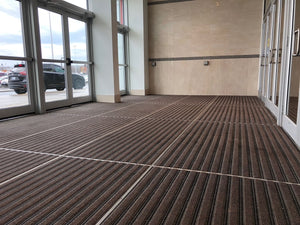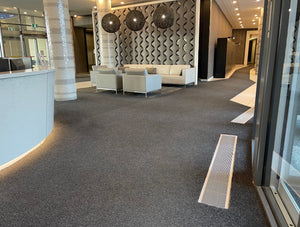GET A FREE QUOTE

Common Matting Problems and How to Solve Them
Introduction
Commercial mats are essential for maintaining a safe, clean, and professional environment. However, businesses often encounter common matting issues that can affect performance, longevity, and safety. This guide will explore these common matting problems and provide expert solutions to keep your business space well-maintained and safe.
1. Mats Not Staying in Place
Problem: Mats shift or slide, creating a tripping hazard instead of preventing one.
Causes:
-
Lack of anti-slip backing
-
Incorrect mat size or weight
-
Placement on a slippery surface
Solution:
-
Use mats with a non-slip rubber backing for stability.
-
Ensure mats are heavy-duty and properly fitted to the space.
-
Use double-sided mat tape or gripper underlays for added security.
2. Mats Wearing Out Too Quickly
Problem: Mats show excessive wear and tear, reducing effectiveness.
Causes:
-
Low-quality materials
-
High foot traffic beyond mat capacity
-
Improper cleaning methods damaging fibers
Solution:
-
Choose commercial-grade mats designed for heavy traffic.
-
Rotate mats regularly to distribute wear evenly.
-
Follow manufacturer-recommended cleaning procedures to prevent fiber damage.
3. Water Accumulation and Poor Drainage
Problem: Mats become waterlogged, creating a safety hazard.
Causes:
-
Lack of proper drainage
-
Using the wrong type of mat for wet areas
-
Insufficient maintenance
Solution:
-
Install drainage mats in wet-prone areas like entrances and kitchens.
-
Use absorbent entrance mats to trap excess moisture.
-
Regularly shake out and hang mats to dry to prevent mold buildup.
4. Mats Not Effectively Trapping Dirt and Debris
Problem: Mats fail to keep floors clean, allowing dirt to spread indoors.
Causes:
-
Mats too small for entryway coverage
-
Low dirt-trapping capacity
-
Lack of regular cleaning
Solution:
-
Choose entrance mats with a deep-groove design to capture debris.
-
Use multi-zone matting (scraper mat outside, absorbent mat inside).
-
Clean mats regularly with vacuuming and shaking to maintain effectiveness.
5. Mats Curling at the Edges
Problem: Mat edges lift, creating a tripping hazard.
Causes:
-
Poor-quality mat backing
-
Exposure to extreme temperatures
-
Improper storage or handling
Solution:
-
Use mats with beveled edges to reduce curling.
-
Place mats in temperature-stable environments.
-
Flatten curled mats by weighing down edges overnight with heavy objects.
6. Odours and Bacterial Growth in Mats
Problem: Mats develop unpleasant smells due to trapped moisture and bacteria.
Causes:
-
Insufficient cleaning
-
Poor ventilation
-
Mats made of absorbent materials in wet areas
Solution:
-
Opt for anti-microbial treated mats for bacteria prevention.
-
Clean mats thoroughly and regularly with disinfectants.
-
Ensure mats are completely dry before placing them back in use.
7. Mats Becoming Too Slippery
Problem: Mats that should prevent slips end up being slick themselves.
Causes:
-
Residue from improper cleaning products
-
Worn-out anti-slip backing
-
Buildup of grease or water
Solution:
-
Use non-greasy, residue-free cleaners when washing mats.
-
Replace mats when anti-slip properties wear out.
-
Dry mats thoroughly before placing them back on the floor.
Conclusion
Investing in high-quality commercial mats is only part of the equation. Proper care and selecting the right type of mat for each environment ensure long-term performance. By addressing these common matting problems, you can enhance safety, extend mat lifespan, and maintain a clean and professional space.


